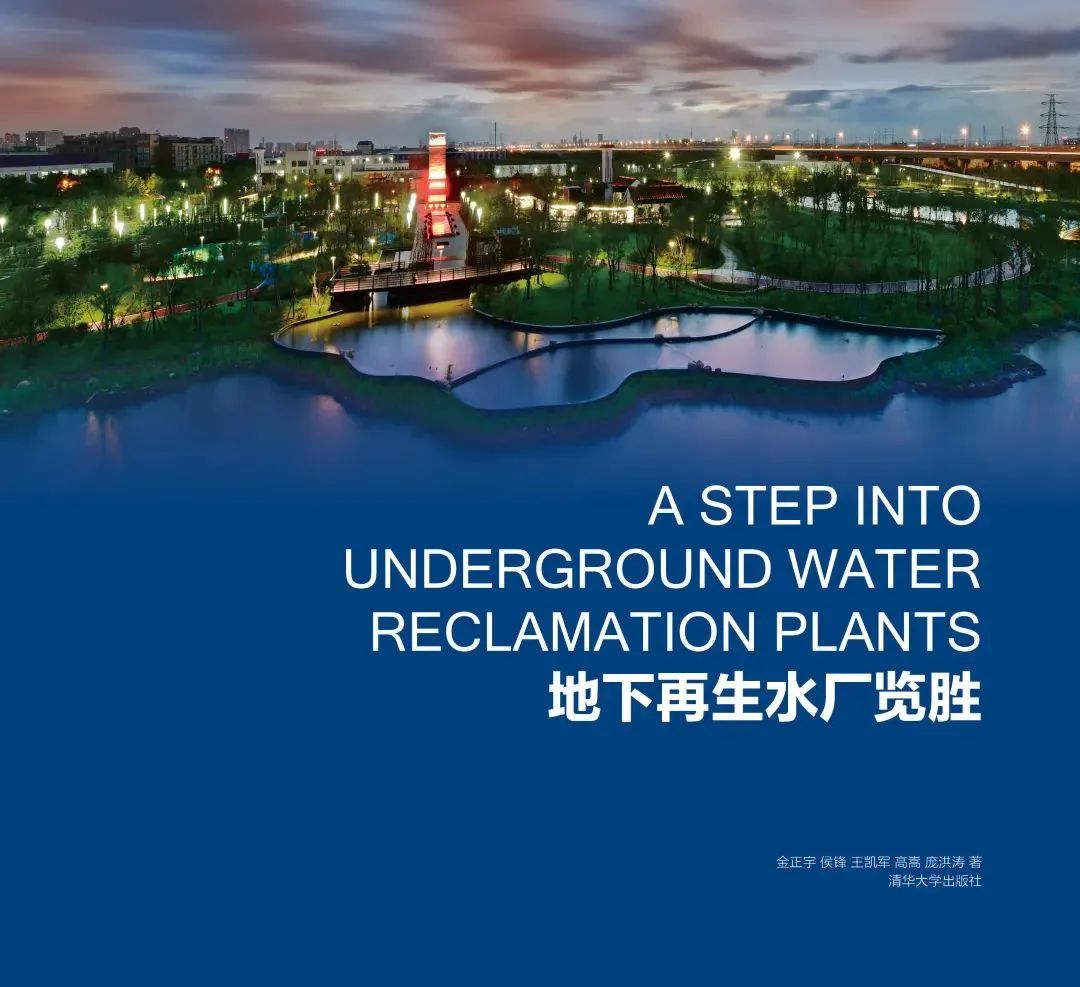Breaking News! Tsinghua University Co-authored with China Water Environment Group to Publish the First Casebook of Global Underground Wastewater Treatment Plants
2022-04-18The transition fromabove-groundto underground is acrucial phasein theevolutionof wastewater treatment construction mode and technology.
Recently, Tsinghua University Press published "A StepintoUnderground WaterWastewater TreatmentPlants" for national distribution. The book was planned by Professor Wang Kaijun of Tsinghua University, edited by Associate Professor Jin Zhengyu of Minzu University of China, and co-authored by China Water Environment Group and others.
Underground wastewater treatment plantsemerged with the development of country's ecological civilization and the rate of urbanization. By changing the functional form of the original wastewater plant, it can be integrated with the community, the environment and land and other aspects. However, due tothe difficultyof construction, questions have been raised about cost, safety and other issues. Regardless of how the issues can be solved, China has become the country withthe greatestnumber ofunderground wastewater plantspracticesin recent years. China Water Environment Group, as an innovator and leader of distributed underground reclaimed waterecosystems, has changed thetraditionalmodel of collecting and treating wastewater as pollutantsin cities and towns all over the world for a century, and treated it as a stable water resource for scientific collection, treatment and resource utilization, creating a number of innovative practical examples of underground wastewater treatment plant technologies and models. The book introduces in details of the Group's model for the treatment of the Dali Erhai Lake and the Nanming River in Guiyang, as well as the specific practice of creating ecological complexes in Beijing's urban sub-center, Shanghai and Chengdu, and provides an in-depth interpretation of the "Technicial Guideline for Underground Municipal Wastewater Treatment Plant" led by the Group.
When it comes to China’s underground wastewater treatment construction, is this a viable option or just a desperate move? "A StepintoUnderground Water Reclamation Plants" was bornas a result of this rigorous sorting and review of previous practical experience.

The cover of the book shows the night view of China Water Environment Group Shanghai Jiading District NanxiangUnderground Wastewater Treatment Plant
FOREWORD
Professor Wang KaiJun,Tsinghua University
Since the beginning of the 21st century,China has reached 60% urbanization rate in only 20 years. The construction of wastewater treatment plants haskept pacewiththis rapid urbanization,and water plants have been surrounded by urban construction.These traditional above-groundwastewatertreatment plants have imposing aeration tanks, sedimentation tanks and wide plant areas, occupying a large amount of urban land and limitingnearby property’s potential forthe development and use.
Strong industrial atmospherewithhigh energy consumption.The majority ofChina's urbanwastewatertreatment plants are centralized, traditional water plants are still committed to solving the problem of water treatment through large-scaleconstruction,long-distance pressurized transport ofwastewater, high energy consumption to promote the operation of processes and other extreme construction techniques. Qiu Baoxing, former vice minister ofMinistry of Housing and Urban-Rural Development, has referred to suchwastewatertreatment plants as "Ford-typewastewaterplants". Industrial civilization has rapidly advancedhumanity in the process ofmodernization, but also resulting inNot-In-My-Back-Yardevents, limited landdevelopment,high energy consumptionand frequentsecondary pollutionissues inthe field of urban domesticwastewatertreatment. Makingwastewatertreatment plants has become a "negative ecological capital" of the city. Therefore, China took the lead inpromotingthe "ecological civilization" - a social form with the basic purpose of the harmonious coexistence ofhumanand nature,humanandhuman,human and society, virtuous cycle, comprehensive development and sustainable prosperity.Moreover, wastewatertreatment should havea greater"ecological civilization"purpose.
Undergroundwastewatertreatment plants were createdwith its space-saving, environmentally friendly and otherbenefits and have grown rapidlythroughoutthe "12th Five-Year Plan" period. Consequently,theargument over the expansionof undergroundwastewatertreatment plants has continued,which has sparked considerable interest from mediaand internationalspecialists alike.At theperiodin 2015, Professor Zuo Jianeand I launched the Engineering DoctorsInternationalSummit Forum of Tsinghua University for the first batch of engineering doctors, and achieved a certain consensus on the model of undergroundwastewatertreatment plants: we shouldadopt a historical perspective, macroscopically examine the phenomenon of undergroundwastewater treatmentplants,exploittheir advantages, and follow the trend.Wastewatertreatment plants shouldtransform frompassive construction into active pursuit. “Negativeecological capital" should betransformed into“positive ecological capital”on the basis ofecologicallyfriendly, environmentally friendly,andcommunity-friendly, etc.
During the “13th Five-Year Plan” period, China's underground wastewater treatment plantshave grown from60 to 70, increasing the treatment capacityby around10 millioncubic metersperday.We should take a close look at this as a typicalexample of social demandclarifies the missionof environmental infrastructure function.In September 2018, I was invited to give a keynote report at the European Water Technology Week in the Netherlands, introducing the successful practical experience of the undergroundwastewatertreatment plant model in China. Many foreign experts and scholars in attendance said that the European concept is mentioned more but with less practice, andweresurprised to see that China has really practiced the proper model of municipal public facilities. This proves once again that we have chosen a technicalpathwith international advancement, and we have gone through thedecades of the West’sdevelopment process in only ten years.
We have already answered the question of whether or not to build. Next, we need to figure out how to develop and promote the underground wastewater treatment plants.
During my tenure as an expert in the Beijing-Tianjin-Hebei section of the "13th Five-Year Plan" for Special Project on Water Pollutionand leadinggroup of the Special Project on Water Pollution, I used China Water Environment Group's TongzhouBishuiWastewater TreatmentPlant project as afoundationfor transforming the results of the urban water ecological complex. This initiative willnot onlyimprove the landscape and surrounding environment, but also provideadditionalsocial functions and services, making itan excellent exampleof the "ecological complex" from planning to implementation.
Engels once said, "The apecompleted a critical step in the transition into a man by descending from the tree".In this way,wastewatertreatment plants fromabove-groundto underground is also a key step in the development ofitsconstruction modeandtechnology. Overall, thewastewatertreatment plant into theunderground is only the first stepin a protracted process that will necessitate continued long-term investment fromthe state, society and the companyitself. "EcologicalCivilization" is not a political slogan, but requires theinvolvementofthe entire community. Aside from these advantages, the water environment management industry's innovations and contributions have made a significant impact on ecological civilization, which is why the wastewater treatment plant is border-less in scope, serving the demands of the timesand playing the function of social, industrial andnatural services. Moreover, the related technical and engineering challenges also require more wisdom from the industry to integrate and innovate towards the future.
FOREWORD
Hou Feng, Chairman of China Water Environment Group
"Great Virtue is like water, water benefitsall things and does not compete." With water as the intermediary, all things are interconnected. Water is the origin of all things and the eternal theme that supports the development of human society.
To retrospect the waved life,it seems that I was still the young man who sailed to theChinaAcademyofEngineeringPhysicson the green train. Inspired by the spirit of the old generation such as Deng Jiaxian, I became one of the many young people who devoted themselves to the cause of national defenseresearchand industry. Little did I know that more than2 decadeslater, I would have the honor of becoming one of the first Environmental Engineering Doctors of Tsinghua University.
First Engineering Doctors at Tsinghua University began in 2012 with a goal of cultivating top engineers. As urbanization progressed, I became certain that above-ground wastewater treatment plants would face numerous challenges.So,with the help of academician Qian Yi and my mentor Professor Wang Kaijun, I shifted my focus to study into underground treatment plants. Additionally, the spirit of Tsinghua's "Continuous self-improvement and moral support" resonated strongly with me during my study at the university.
In July 2015, Tsinghua Universityrequested thatevery engineering doctor share their learning results to the society, andI presented"Focus on undergroundwastewatertreatment plant"atthe First Engineering Doctor of Summit Forum Tsinghua University. This is the first time that domestic experts and scholars publicly focusedonundergroundplants. At that time, the understandingwasnot consistentand there were more conflicting views.In 2017, the topic of "innovation in the construction mode of undergroundwastewater treatmentplants and demonstration of ecological complexes" wasassigned to the Ministryof Ecology and Environment’s13th Five-Year for Special Project on Water Pollution. As theprojectleader, I collaborated withTsinghua team,Peng Yongzhen academician teamandthe joint efforts of colleaguestocomplete the national major issuesas well as effectiveapplication of technical results in the countryandforming a number of national major demonstrations. This book shows severalsuccessfulpracticesin the industry: Nanming River in Guiyang, Guizhou Province,Dao Xiang Lake in Beijing, Chengdong in Jiaxing, Zhejiang Province, Futian in Shenzhen, Guangdong Province, etc. On the occasion of the publication of this book, I would like toexpress my gratitudeto the academicians, experts, peers and others who haveprovided me with a great deal of assistance andsupport along the way and have continuously pushed for technological iteration and innovation.
"Sail but believe in the wind, there is no limit to the vastness of the line, ".For the new green infrastructure of the country and thehigh-qualitygreendevelopment ofour community, let's work together tocontribute.
This bookcombines the extensiveresearch results of industry experts and the practical experience of typical enterprises in the form of illustrations and text. Additionally, the book presents overone hundred typical engineering cases at home and abroad. Readers will have the opportunity to learn about unique undergroundwastewater treatmentplants around the world.
 中国水环境集团
中国水环境集团









